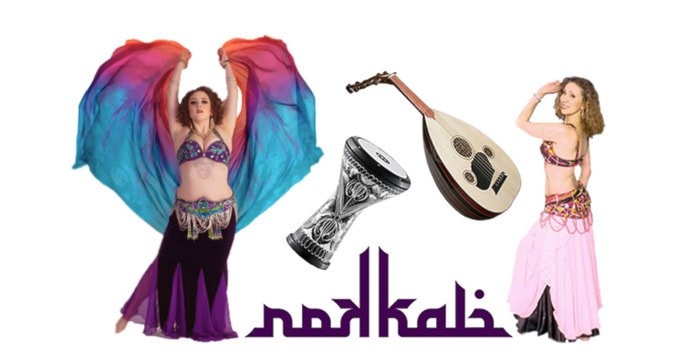At last year’s Traditional Music Festival audiences were delighted by the gyrations of Aviva the belly dancer. Aviva is back this year and has brought with her another belly dancer as well as a Middle Eastern band. Rakkab from Vancouver plays traditional Turkish, Arabic, Hebrew and Greek music. The group consists of Dan (Shareef) Mason on baglama saz (Turkish long-necked lute), Larissa Payne on vocals, Bill MacLachlan on bouzouki and flute, and Mike O’Connor on darbukka (goblet drum). They have been playing together since 2003. Rakkab is very excited to feature the sparkle and grace of premier oriental belly dancers Aviva and Nina D who are known for their engaging stage presence and classical style. Aviva Finkelstein has sent in some background information about belly dancing.
The term ‘belly dance’ is a widely used and sometimes misleading term. Yes, belly dancers are well-known for their undulating and shimmying bellies but the art of belly dance itself is an old and complex art form which truly embodies the connection between musician and dancer. Included under the umbrella term of “belly dance” are a number of dances from different regions, styles, and time periods. Some of these styles are old and have direct roots in the Middle East and Mediterranean while others are new and Westernized forms of the dance and bear little resemblance to their Middle Eastern beginnings. Some of the more widely recognized styles include Turkish, Tribal Fusion, and Raqs Sharqi.”
Turkish belly dance features a heavy emphasis on grounded hip and pelvic movements. Turkish belly dancers often perform with zills (finger cymbals) and are well known for being adept at playing more complex rhythms on their finger cymbals. Modern Turkish belly dance has strong roots in Turkish Roma culture and music and because of this it is generally thought of as being less suited for stage and more suited for parties and family gatherings. As well, Turkish belly dancers are distinguishable by their unique costumes with feature long and heavily beaded fringe and a v-shaped belt.
Tribal fusion is a far more modern style of dance and is said to originate in the USA in the 1960’s. Tribal fusion is a very broad term and encompasses a number of sub-styles but is often characterized by snaky movements and distinct costumes featuring elaborate jewelry, headpieces, coins, and tassels. Costumes rarely include the beaded fringe, rhinestones, and sequins used on Turkish and Raqs Sharqi costumes. Because this style of dance is so dynamic and modern, dancers utilize a wide variety of music that includes everything from rock and roll to electronic music, though they rarely dance to live music.
Raqs Sharqi’ is the term used to describe Egyptian cabaret belly dance. This style of dance holds its roots firmly in Middle Eastern musicality and movement but has been adapted for the stage. Today’s Raqs Sharqi dancers take inspiration from ballet and so the movements are lifted and graceful with much movement across the allotted space. Many Raqs Sharqi dancers are firm believers in maintaining the pure connection between music and movement and so do not choreograph their pieces and prefer to dance with live musicians. Raqs Sharqi costumes are over the top and sparkly! They feature intricate beading, crystals, and rhinestones and often dancers will perform with zills, a veil, or other props.
For all belly dancers - but especially Turkish and Raqs Sharqi belly dancers - their performances are as much about audience engagement and interaction as they are about a showcase of technical skill and ability. Don’t be scared to clap and whistle or to yell “yalah” (Arabic for “Yeah! Let’s go!”), “aywah” (Arabic for “Yes!”), or “helwah” (Arabic for “beautiful”). Or if you’re really brave, try your hand at a zaghareet (the high pitched trill sound made by repeating “lalalalala” quickly).
The streets of Princeton will be vibrating and glittering when Rakkab and the two dancers get going. Come and experience them on the weekend of August 15 – 17. The Festival begins on the town square on Friday 15 August at 6:15 p.m. Then there is music from 10 a.m. until 6 p.m. on Saturday and Sunday right in downtown Princeton. The best thing about it is that it’s free – no admission is charged. It is run entirely by volunteers including the musicians. If you would like to find out more, visit the Festival’s website at www.princetontraditional.org. If you’d like to help out at the Festival the committee would love to hear from you. You can email princetonfestival@telus.net or phone 250-295-6010.
